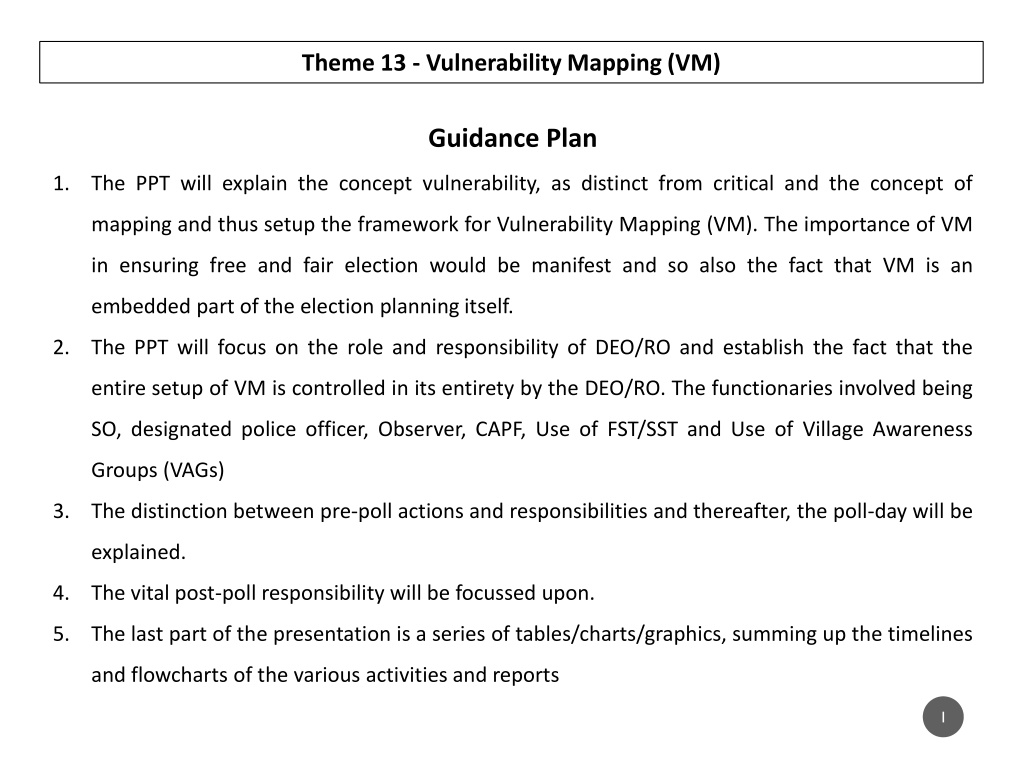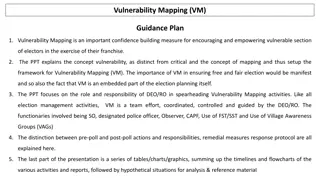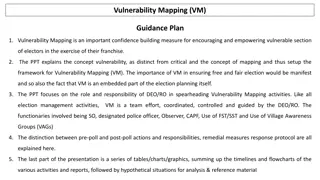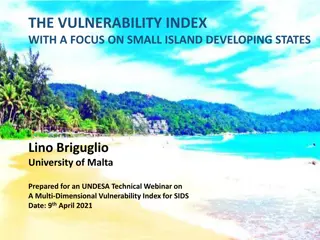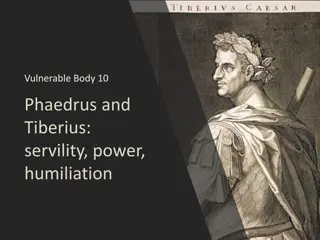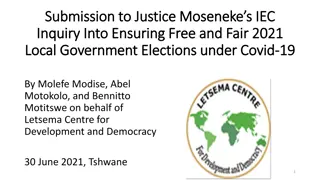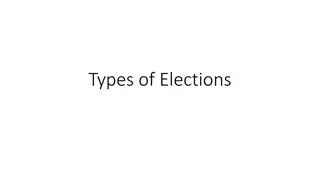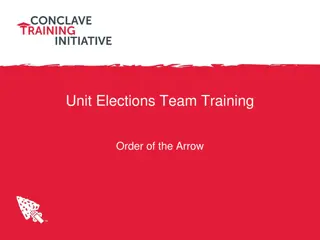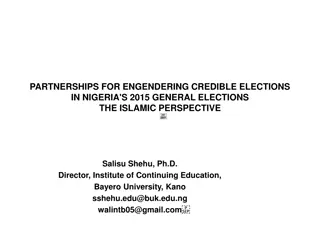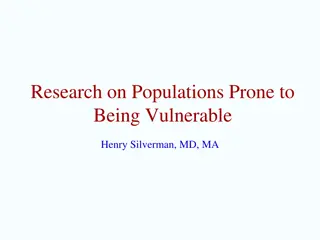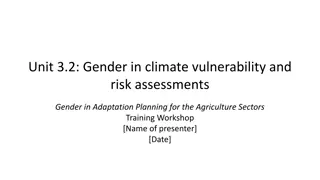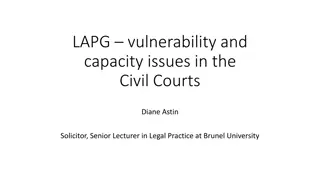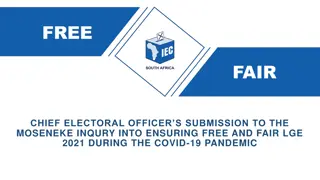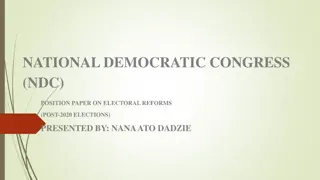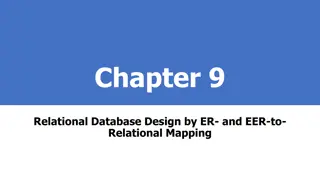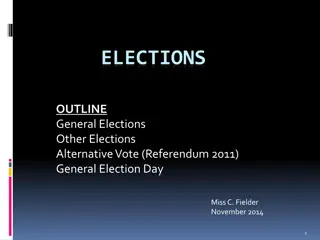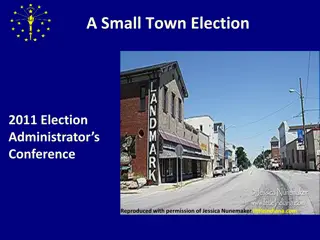Understanding Vulnerability Mapping (VM) for Ensuring Free and Fair Elections
This PowerPoint presentation delves into the concept of vulnerability mapping (VM) in the context of election planning, emphasizing the role of District Electoral Officers (DEOs/ROs) in controlling the entire VM process. It outlines pre-poll and poll-day responsibilities, as well as post-poll actions. The presentation also includes references to critical polling stations, demographic data, and guidelines for sector officers. Visual aids and descriptions help clarify the importance of identifying and addressing vulnerabilities to safeguard the integrity of elections.
- Vulnerability Mapping
- Elections
- District Electoral Officers
- Election Planning
- Vulnerability Identification
Download Presentation

Please find below an Image/Link to download the presentation.
The content on the website is provided AS IS for your information and personal use only. It may not be sold, licensed, or shared on other websites without obtaining consent from the author. Download presentation by click this link. If you encounter any issues during the download, it is possible that the publisher has removed the file from their server.
E N D
Presentation Transcript
Theme 13 - Vulnerability Mapping (VM) Guidance Plan 1. The PPT will explain the concept vulnerability, as distinct from critical and the concept of mapping and thus setup the framework for Vulnerability Mapping (VM). The importance of VM in ensuring free and fair election would be manifest and so also the fact that VM is an embedded part of the election planning itself. 2. The PPT will focus on the role and responsibility of DEO/RO and establish the fact that the entire setup of VM is controlled in its entirety by the DEO/RO. The functionaries involved being SO, designated police officer, Observer, CAPF, Use of FST/SST and Use of Village Awareness Groups (VAGs) 3. The distinction between pre-poll actions and responsibilities and thereafter, the poll-day will be explained. 4. The vital post-poll responsibility will be focussed upon. 5. The last part of the presentation is a series of tables/charts/graphics, summing up the timelines and flowcharts of the various activities and reports 1
Part A Concept of VM 2
Reading/reference material DEMP VM-MANUAL-(https://eci.gov.in/files/category/138-vulnerability- mapping/) List of Critical Polling Stations of last election with details of issues Demographic details- Caste/Minorities Caste Matrix- Village/polling station wise 3 Contd
Reading/reference material Contd. Election offences/Statistics and crime record in VM-I format (AC wise) Checklist for Sector officers/Magistrates - (https://eci.gov.in/files/file/32-sector-officers/) Providing link/copies of Handbook for Executive Magistrate and copies of CrPC (Chapter10) (https://www.scribd.com/document/148117367/Handbook-for-Executive- Magistrates) 4
Understanding vulnerability VM Susceptibility-intimidation-undue influence- force on the voter: Susceptibility of any voter or section of voters, whether or not living in a geographically identifiable area, to be wrongfully prevented from or influenced upon in relation to the exercise of his right to vote in a free and fair manner, through intimidation or use of any kind of undue influence or force on the voter 5 Contd
Understanding Mapping contd. Confidential/dynamic report of vulnerable areas of the constituency: Listing and marking vulnerable areas/Pockets/ Villages/Polling Station on the constituency map and including in the DEMP. The report is confidential and dynamic 6
Vulnerable vs Critical Difference/relation between vulnerable areas and critical areas: Vulnerable Critical Specified in circular dated on 12th Oct 2007 Criteria explained in a separate letter of the same date & revised on 24th Oct 2008 For polling station Based on last election (Objective) For Voters/Segment etc. Perception for upcoming election(Element of Subjectivity) The polling stations having vulnerable pockets are treated as critical. 7
Parameters of VM Pre-Poll Complaints Act of political parties (Violations of MCC) Inputs from the worry lists by candidates Information sharing from the voters 8
Legal framework S 171C IPC: Undue Influence at Elections- Whoever voluntarily interferes or attempts to interfere with the free exercise of any electoral right commits the offence of undue influence at an election. S 123(2) RPA 1951: Any direct or indirect interference or attempt to interfere on the part of the candidate or his agent, or of any other person with the consent of the candidate or his election agent with the free exercise of any electoral right is a Corrupt Practice. 9
Part B Administrative setup and responsibilities down the line entire responsibility with DEO/RO: o appointment of SO & Police Officers o Training of SO & Police Officers o Preparation of action plan 10
Responsibilities of DEO/RO 1. When to Start- 6 Months in advance 2. What to do- I. Appointment letters and Identity Cards to SOs II. Training- First training immediately after the appointment Second training after the announcement of election (Due to replacements) III. Procuring and providing VM-I IV. Providing copies of VM manual and Checklist for Sector Officers V. Conferment of the powers of special executive magistrate to SO. 11
Action plan Identifying Vulnerable areas persons/factors causing vulnerability corrective action To identify vulnerable voters/sections of voters To identify the persons/factors causing such vulnerability and To plan and take adequate corrective action well in advance 12
Appointment of Sector Officers Appointment of SO One of the most responsible positions, so the best officers are to be identified, better if experienced & conversant of the area. To supervise 10 to 12 PSs. Central Govt. officers can be deployed. Should be equipped with vehicle, fuel, mobile phone, ID cards etc. Shall be designated as Sector/Zonal Magistrates. 13
Sector/designated police officer Designated Police Official for VM to work in coordination with SO Police Official at Thana level: Not below the rank of Assistant Sub- Inspector or Head Constable of police. Conduct joint exercise of VM with SO Tracking the individual trouble mongers ensuring that trouble makers are kept under watch Designated Police Officer at Thana (Police Station) Level for VM and ensuring Law and Order and peaceful poll. 14
Training of SO/ designated police officers Training supporting material/past record for guidance - Train jointly and provide following- i. PS wise AMF details ii. Voter turn out(last election) iii. Gender Ratio iv. Route map v. MCC violation cases(last election) vi. LOR-1 & LOR-2 (Law & Order Report) 15 Contd
Part C Pre-poll and Poll day responsibilities o DEO/RO/SP o SO o Designated Police Officer o Observer o CAPF o Use of FST/SST o Use of Village Awareness Groups (VAGs) o Utilization of other revenue and magisterial staff of the district o Reporting formats and frequencies 16
Pre-poll responsibilities(SO) Identifying physical Infrastructure/accessibility of constituency areas identification of pockets/persons - 1. Frequent visits in sector for- Checking the status of accessibility and Terrain/Road condition of the sector(PS wise) for inclusion in DEMP also. Checking the status of the network accessibility of respective Telecom service providers(PS-wise) for inclusion in DEMP also. Identification of vulnerable village and hamlets/segments. Identification of persons who make it vulnerable (Report in VM- 2 & 3). Identification of electors in terms of vulnerability To act as Sector/ Zonal Magistrate accompanied by police officer. prepare a Sector/Zonal Magistrate Plan. 17 Contd
Pre-poll responsibilities(SO) contd. Techniques employed to create VM Report confidence-building measures confidentiality of informers: 2. Have details of and meetings with - Contact person, source within the vulnerable community Labour Inspector and food and supply officers for identification of vulnerable areas. Heads of educational institution, specially residential institutions. Factory godown owners Persons running printing press With VAG members, RWAs, Gram Pradhan, Sarpanch for confidence building. 3. Prepare list PS wise with name of village, hamlet, potential troublemakers, their address, and so on. Maintain complete confidentiality of the informers/source. 4.After the visit submit reports in VM 2 & 3 and summary in VM - 4 18
Poll day responsibilities: SoP for Poll day frequent visit to vulnerable pockets - remain alert to complaints use FSTs I. Frequent checking of the vulnerable sections identified earlier. II. In case of receiving alarming messages; RO and district administration be informed immediately. III. To keep a check on vulnerable sections with the help of FSTs. (Subject to change as per local requirements) 19 Contd
Poll day responsibilities - Role of DEO/RO/SP contd. Dealing with trouble mongers joint visits to locations - preventive detention confiscation of arms DEO/RO/SP- Names and contact details of persons within vulnerable group. DEO/SP- Prepare a focused action plan to deal with- Binding identified trouble mongers Confiscation of arms Preventive detention Appearance in local police station/police pickets etc. DEO/SP, RO/DySP, SDM/Tehsildar/Police Inspector- joint visits/rounds on such locations and meet the communities for confidence building. DEO/RO/SP shall also interact with candidates/political parties. 20 Contd
Poll day responsibilities - role of DEO/RO/SP contd. Measures to gather inputs and take corrective actions to diffuse vulnerability: Take regular feedback on each subject from District Intelligence(L.I.B) Deploy dedicated police teams in vulnerable pockets to locate voters at convenient places for fast movement on poll day (shall be included in District Security Plan). Form Village Level/ Ward Level Awareness Groups(VAGs/WAGs) to gather information of vulnerability and do confidence building. Ensure 24 hours surveillance by FSTs, SSTs, VVTs. Undertake required SVEEP measures. Measures are to be undertaken in non-partisan manner 21 Contd
Poll day responsibilities - role of CPF contd. DEO to provide list of vulnerable locations to CPF CPF Commanders to visit such vulnerable locations Area Domination & Flag March. To immediately report to RO/DEO/SP/Observer/Sector Officer if any obstructions. 22 Contd
Poll day responsibilities - role of Observer contd. Action by observer visit vulnerable locations constant monitoring: DEO/RO shall hand over the details of polling station-wise Vulnerability Mapping of Constituency to the Observer ( in annexure VM-6(RO) &VM- 7(DEO). The Observer shall visit vulnerable locations and interact with the voters. The Observer shall constantly monitor the development. 23 Contd
Poll day responsibilities - poll day monitoring contd. Measures to tackle vulnerability on real-time basis on poll day visit atleast twice adequate security deployment: Briefing to presiding officers by RO at dispatch center SO report to RO of low % turnout at vulnerable PS Sector Magistrate/Mobile Forces visit at least twice Visit by Observer and Senior Officers Police patrolling to keep track, police pickets if needed CPF Commanders visit- if any obstruction report to RO/DEO/SP. Adequate security deployment 24
Part D Post poll responsibilities 25
Post poll responsibilities - monitoring after the poll Post-poll stocktaking of vulnerability/intimidation: Take inputs on mass scale intimidation/threat/ obstruction Observer to pay full attention to the issue of VM and verify it at every stage Proper analysis of Form-17 A and Marked copy of Roll during scrutiny. 26 Contd
Post poll responsibilities - accountability and confidentiality contd. Need to maintain confidentiality regarding details of VM/sources of information security deployment details not to go in public domain: Accountability of various civil and police officials for Vulnerability Mapping of each polling station/constituency. No press conference/furnishing of details of VM, Vulnerable areas, hamlets, troublemakers & the sources of information or deployment of security forces in public domain. VM portion of DEMP- to be shared with concerned officials as separate handout Severe disciplinary action for dereliction of duty. 27
Part E Reports and timelines 28
Reports flowcharts Sl No 1 Format Subject Matter Sender/Receiver Timeline VM- I (Annexure- I) VM -2 (Annexure- II) Election Offences and Crime Record Statistics(AC wise) Vulnerable areas (Sector Wise) SO DEO RO SO 2 SO RO Submit within 3 days of announcement of election 3 VM-3 (Annexure- III) People causing vulnerability(Sector Wise) SO RO Submit within 3 days of announcement of election 29 Contd
REPORTS FLOWCHART - contd Sl No 4 Format Subject Matter Sender/Receiv er SO RO Timeline VM-4 Summary of Vulnerable/ polling stations(Sector Wise) Submit within 3 days of announcement of election Submit within 3 days of announcement of election submit within 5 days (Annexure-IV) 5 VM-5 SO RO DEO Sector Police Officer s report(Sector Wise) (Annexure-V) 6 VM-6 Abstract of Vulnerable polling stations(AC) RO DEO (Annexure-VI) 7 VM-7 Abstract of vulnerable polling stations (Hold District) DEO CEO ECI submit within 5 days (Annexure-VII) CEO to compile and send to ECI within 10 days of announcement of election 30
Timeline for VM Sl. No 1 Activity Timeline Collection & compilation of basis information on each AC by DEO/RO (as per Annexure-I) Six months before the election 2 Updation of basic information by DEO/RO (as per Annexure-I) Before handing over to Sector Officer 3 Appointment of Sector Officers & Police Sector Officers About six to four months before the election. 4 Appointment of Designated Police Officer at police station level About six to four months before the election. 5 Training of Sector Officers & Designated Police Officers & handing over of basic information of AC to Sector Officers by DEO/RO Four to two months before the election 31 Contd
Timeline for VM contd. Sl. No 6 Activity Timeline Making Law and Order Portal of State functional by ECI Four months before the election. 7 Identification of vulnerable areas/ segments/villages/hamlets, persons causing such vulnerabilities in Annexure-I, II, III, IV & V After the issue of Press Note by the Commission and before the issue of the gazette notification. 8 Identification of the persons causing such vulnerability Within 5 days of issue of gazette notification 9 Submission of all VM reports in formats by SO (in Annexure II, III, IV & V) to RO Within 3 days of announcement of elections 32 Contd
Timeline for VM contd. Sl.No Activity Timeline 10 Compilation of all Sector Officers reports by RO and submission to DEO (in Annexure.VI) Within 5 days of announcement of elections 11 Compilation of VM reports of all ROs by DEO &submission to CEO (in Annexure VII) 7 days of announcement of elections 12 Certificate of NO Vulnerable village/area in Assembly Constituency, by DEO to CEO 7 days of announcement of elections 13 Compilation of VM reports of all DEOs by CEO for submission to ECI 10 days of announcement of elections 33 Contd
Timeline for VM contd. Sl.No Activity Timeline 14 Action against the persons responsible for causing vulnerability before 5 days before day of poll. 15 Plan and execute joint confidence building visits/Flag March by DM/SP; SDM/DySP; Tehsildar/PI in areas identified as most vulnerable. 2 weeks prior to poll day 16 Pre-poll area domination by CPF 3-5 days before poll day. 17 Strict vigil and monitoring of vulnerable areas/persons by Observers/DEO/RO/SO/Police On the Poll day 34
Part F Hypothetical Situation for analysis 35
Hypothetical situation for analysis On the poll day in a parliamentary election there is information received telephonically that some voters of a particular segment are being prevented from approaching the polling station to vote. What possible action points are suggested ? write action points in chronological order 36
